When Donald Trump first floated the idea of imposing heavier tariffs on certain imports from the European Union, most observers glanced west—towards Germany’s mighty car industry and France’s luxury goods sector.
But the knock-on effects of such tariffs would reverberate across the entire bloc, not least among the economies of Central and Eastern Europe.
Countries such as Poland, Czechia, Hungary, and Slovakia are deeply integrated into pan-European supply chains, and the United States is an increasingly important market for select goods.
Were Trump to proceed with punitive duties, they would come as an unwelcome shock to a region that has painstakingly cultivated a reputation for manufacturing expertise and cost competitiveness.
The anatomy of CEE exports
Central and Eastern Europe’s export profile to the United States has evolved remarkably in recent years. High-value manufactured products dominate. Poland, for instance, sends an array of machinery, furniture, and electronics.
Czechia and Slovakia, major automotive hubs, supply engines and spare parts to American carmakers. Hungary’s pharmaceutical industry and Romania’s IT services sector have also gained traction in the US market—though on a smaller scale than the region’s staples of machinery and automotive components.
One reason these countries have found success is their integration into supply chains orchestrated by Europe’s largest manufacturers. German automakers often rely on Czech or Hungarian plants for engine components, which are then assembled in Germany before being shipped overseas.
A rise in American tariffs on European cars or parts would instantly pinch these suppliers. Car parts are particularly vulnerable since they represent one of the largest categories of EU exports to the United States by value.
A possible chain reaction
The threat of new tariffs—whether on automobiles, industrial goods, or even agricultural products—could have three principal effects in the CEE region.
First, there is the direct export hit. American buyers, facing higher prices, might switch to domestic or non-EU competitors, denting demand for CEE goods. Secondly, tariffs could weaken the European supply chain structure itself. If Germany’s car exports to America contract, demand for Central European inputs will also drop.
And third, if the tariff tiff escalates into a broader US-EU trade conflict, CEE countries might lose confidence from foreign investors, who have long been attracted by the region’s open access to large markets in both Western Europe and North America.
The automotive sector appears most at risk. Slovakia, the world’s top car producer per capita, is an emblem of the region’s reliance on automobile manufacturing. With a population of under six million people, Slovakia produces over a million cars annually—vehicles that, in various forms, land in showrooms around the globe, including in the United States.
In Czechia, the car industry accounts for roughly one quarter of manufacturing output, rendering it similarly vulnerable. Even in Poland—whose economy is more diversified—the automotive supply chain employs tens of thousands and supports a network of small to medium-sized enterprises.
Manufacturing is not the sole concern. Agricultural exports, though smaller, are also significant for certain CEE countries. Poland, for example, has built a robust export market for processed foods. If Washington slaps broader tariffs on EU food products, Central Europe’s producers will struggle to maintain competitive prices in a tight-margin business. Similarly, sectors like machinery, electronics, and furniture face higher costs if tariffs climb.
The resilience factor
Despite these risks, the emerging Europe region has one advantage: its economies are increasingly diversified and no longer dependent on one single trade partner. Intra-EU trade remains the biggest driver of growth, meaning any direct shock from America’s tariffs may be contained if EU demand stays robust.
Furthermore, as labour costs rise in Central Europe, some governments are incentivising a shift to higher-value industries such as research and development, IT services, and the pharmaceutical sector—sectors less vulnerable to tariffs than heavy industry.
Yet the spectre of a potential trade war remains troubling. Economies that rely on foreign investment, exports, and intricate supply chains prosper in conditions of stability and certainty.
Trump’s renewed flirtation with protectionism undermines that certainty, eroding confidence and crimping investment decisions. Central and Eastern Europe’s success story—built on openness and integration—would be tested if Washington turns talk into tariffs.
Policymakers in Warsaw, Budapest, Prague, and beyond will be watching anxiously. How they adapt could determine whether the region’s robust economic engine keeps humming or sputters under the weight of new barriers at America’s borders.







